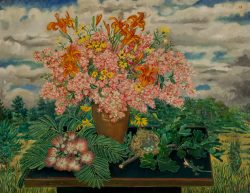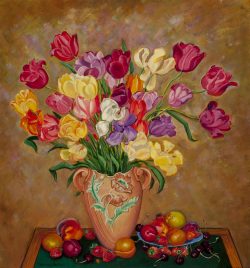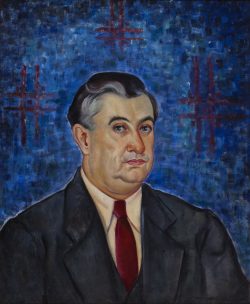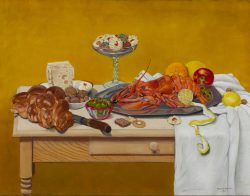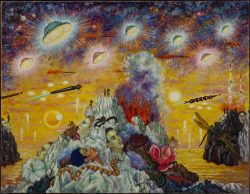Macena Barton, Self-Portrait (detail), undated, oil on canvas (36 by 20 inches), image courtesy of Mongerson Gallery, Chicago.
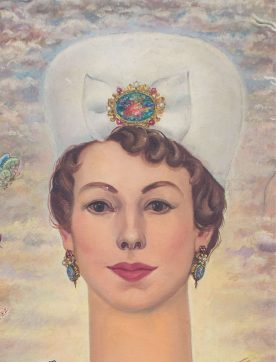
Macena Barton 1901-1986
Born in Union City, Michigan, Macena Alberta Barton worked as a bank clerk and proofreader to support her studies at the Art Institute of Chicago from 1921 to 1925. There her most influential teacher was visiting instructor Leon Kroll, who encouraged his pupils to study the works of the Post-Impressionist masters in the museum’s Helen Birch Bartlett Memorial Collection. Focusing from the beginning on the nude and on portraiture, Barton also painted numerous still-life images and later essayed straightforward cityscapes and surrealist fantasies. She debuted in the Art Institute’s annual exhibitions in 1926 with the first of her many self-portraits. Strongly colored and strikingly bold, her paintings attracted immediate attention, and in 1929 Barton was given a small solo exhibition at the Art Institute. In the following decades, she participated in exhibitions across the U.S. and was particularly active in Chicago galleries and organizations, with solo shows at M. Knoedler & Company in 1931, at Findlay Galleries in 1936, and at the Chicago Galleries Association numerous times in the 1930s and 1940s. Toward the end of her career Barton exhibited in the Arts Club of Chicago’s annual artist-members’ shows.
As influential art critic Clarence J. Bulliet noted in his 1935 profile of Barton, the artist defied categorization. Claimed by conservatives for her technical mastery and by modernists for the disquieting frankness and sometimes gaudy colorism of her paintings, Barton exhibited with artists’ organizations from the radical Chicago No-Jury Society of Artists to the traditionalist Association of Chicago Painters and Sculptors. She won critical praise equally from the Chicago Tribune’s conservative Eleanor Jewett and from Bulliet, a staunch champion of modernism, who described Barton as a defiant individualist: “blunt and outspoken, she tears down the curtains of shams—she’s as ‘primitive’ and ‘barbaric’ in her emotions as in her color lusts.”i Reputedly the first American woman artist to paint a nude self-portrait, Barton deployed a garish realism, sometimes with a provocative touch of slick commercialism, for unsettling effect. She is now recognized as one of the foremost surrealist painters of her generation in Chicago.
Wendy Greenhouse, PhD
i C. J. Bulliet, “Artists of Chicago Past and Present. No. 12: Macena Barton,” Chicago Daily News, May 13, 1935.
